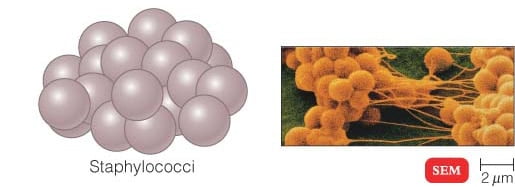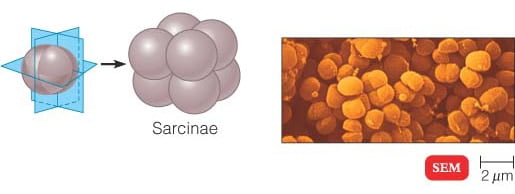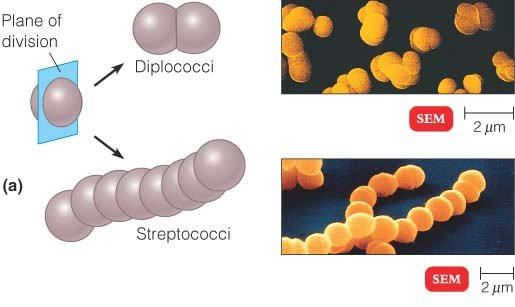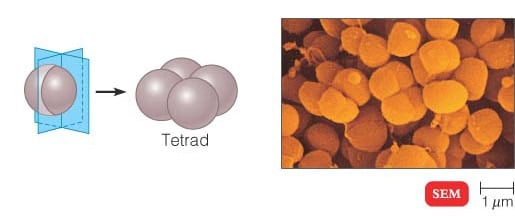Bacterial Morphology - Bacteria Size, Shape and Arrangement
Bacterial Morphology - Bacteria Size, Shape and Arrangement
Definition
- Bacteria are microscopic unicellular organism they are true living organism that belongs to the kingdom prokaryotes.
- (Singular: bacterium) are a large group of unicellular microorganisms.
- They lack membrane-bound organelles like those found in eukaryotes.
- They are extremely tiny thus they cannot be seen individually unless viewed through microscope. When cultured on agar, the bacteria grow as colonies that contain many individual cells. These colonies appear as spots of varying size, shape and colour, depending on the microorganism.
Bacterial Size
- In general, bacteria are between 0.2 and 2.0 um - the average size of most bacteria. Research studies have shown their size to play an important role in survival over time.
- There are some that hold this to range between 1 and 10 micrometers.
- E. coli bacteria range between 1.1 and 1.5 um in diameters, B. anthracis range between 1.0 and 1.2um while B. subtilis range between 0.25 and 1.0 um in diameter.
- Smallest Bacteria: The smallest bacteria are known as nanobacterium(They
are characterized by their slow growth under aerobic conditions as well
as being Gram-negative in nature. Although they have been shown to
range between 0.2 and 0.5um (200 to 500 nanometers) there have been
studies where some were found to filter through 0.1um filters)
- Some examples of these bacteria include Mycoplasmas (about 0.25um), Haemophilus influenzae which ranges between 0.2 and 0.3 um and Mycoplasma gallicepticum which range between 200 and 300 nanometers in diameter.
- * Although such bacteria as mycoplasma lack a cell wall, they can exist independently. They are found in such hosts as human beings, plants and a variety of insects.
- Large Bacteria:
- Some bacteria are large enough to see with the naked eye. For instance, whereas Schaudinnum bütschlii that measure between 4 and 5um in diameter are considered to be large bacteria,
- Thiomargarita namibiensis may grow to be as large as 0.75mm in diameter.
* The Thiomargarita namibiensis is a Gram-negative bacterium that is coccoid in shape. It was discovered in ocean sediments in Namibia (Southwest of Africa).
Bacterial Shape
There are present mainly three type bacterial shape this are included,
- Bacilli (or bacillus for a single cell) are rod-shaped bacteria.For example – Bacillus cereus, Clostridium tetani.
- Cocci (or coccus for a single cell) are round or spherical shape cells.For example – Staphylococcus aureus, Streptococcus pyogenes.
- Spirilla (or spirillum for a single cell) are curved bacteria which can range from a gently curved shape to a corkscrew-like spiral.(Many spirilla are rigid and capable of movement.)For example – Spirillum, Vibrio, Spirochete species.
Arrengment of Bacterial Cell
Arrangement of Cocci
Cocci bacteria can exist singly, in pairs (as diplococci ), in groups of
four (as tetrads ), in chains (as streptococci ), in clusters (as
stapylococci ), or in cubes consisting of eight cells (as sarcinae).
Cocci may be oval, elongated, or flattened on one side. Cocci may remain
attached after cell division. These group characteristics are often
used to help identify certain cocci.
Diplococci:
- Diplococci bacteria are the type of cocci bacteria that occur as a pair (two joined cells).While some of these cells may be truly round shaped, others may appear elongated (ovoid) or bean-shaped/kidney shaped.
- Examples: Streptococcus pneumoniae, Moraxella catarrhalis, Neisseria gonorrhoeae, etc.
2. Streptococci
- Streptococci bacteria are a type of bacteria that arrang in a chain form (resembling chains).
- A majority of these bacterial cells are also ovoid in shape and may form paired chains.
- As members of the family Streptococcaceae, this group of bacteria is characterized by being non-motile, Gram-positive organisms
- Examples: Streptococcus pyogenes, Streptococcus agalactiae
3. Tetrads
- Tetrad bacteria are arranged in groups of four cells. Following division, the cells remain attached and grow in this attachment.
- Examples: Aerococcus, Pediococcus and Tetragenococcus
4. Staphylococci
- Staphylococci Bacteria are a type of bacteria that form grape-like clusters.
- This type of arrangement is the result of division that occurs in two planes.
- Two of the main characteristics of these organisms are that they are immobile, Gram-positive bacteria.
- Examples: Staphylococcus aureus

5. Sarcinae
- Sarcina bacteria occur in groups of 8 cells.
- Unlike tetrads that divide into two planes, Sarcinae is produced through the perpendicular plane division.
- Some of the characteristics associated with these bacteria include being strict anaerobes, Gram-positive bacteria and that measure between 1.5 and 3.o um.
- Examples: Sarcina ventriculi, Sarcina ureae, etc.

Arrangement of Bacilli
Bacillus bacteria have the following traits:- They are all rod-shaped
- They form endospores
- They are facultative anaerobes
Like cocci bacteria, bacillus bacteria are also arranged differently. While some exist as single, unattached cells (e.g. Salmonella enterica subsp, Bacillus cereus, and Salmonella choleraesuis), others are attached.The following are the different types of bacillus arrangements:1.Diplobacilli Bacteria
- Like Diplococci bacteria, Diplobacilli occur in pairs. Following cell division, the two cells do not separate and continue existing as a pair.
- Example of Single Rod: Bacillus cereus
- Examples of Diplobacilli: Coxiella burnetii, Moraxella bovis, Klebsiella rhinoscleromatis, etc.

2. Streptobacilli
- Streptobacilli bacteria occur as elongated chains. As such, they are the result of division on a single plane.
- Examples: Streptobacillus moniliformis
3. Coccobacilli
- Compared to other bacilli, Coccibacilli bacteria are shorter in length and thus appear stumpy.
- Examples: Haemophilus influenzae, Gardnerella vaginalis, and Chlamydia trachomatis
4. Palisades
- Palisades are another type of bacilli bacteria. Cell division of these bacteria results in a type of arrangement that resembles a picket fence. One of the best examples of palisades is the Corynebacterium diphtheria that is responsible for diphtheria.
- Example: Corynebacterium diphtheriae
Arrangement of Spiral Bacteria
Unlike cocci and bacilli bacteria, some types of bacteria appear curved when viewed under the microscope. However, they vary in shape making it possible to differentiate them from each other.
1. Vibrio
- Generally, vibrio bacteria are comma-shaped and thus not fully twisted (curved rods).
- Example: Vibrio cholerae
3. Spirochetes
Spirochetes are characterized by a helical shape. Spirochetes are also flexible and have been shown to produce mycelium. The movement involves the use of axial filaments, which is one of the distinguishing features between the bacteria and other types of bacteria.
* Axial filaments in spirochetes are located between the inner and outer membrane. They run along the length of the bacteria and are responsible for the twisting motion of the organisms.Examples: Leptospira species (Leptospira interrogans), Treponema pallidum, Borrelia recurrentis, etc.
2. Spirilla
- Like Spirochetes, Spirilla bacteria possess a helical shape. However, they are more rigid and have the typical flagella found in other types of bacteria.
- Example: Campylobacter jejuni, Helicobacter pylori, Spirillum winogradskyi, etc.
Other Types of Bacteria based on the Shape
Some bacteria possess various odd shapes that distinguish them from other types of bacteria. These include:- Rectangular bacteria- They appear rectangular in shape e.g. Haloarcula marismortui
- Star-shaped bacteria- Look like stars (star-shaped) e.g. Stella humosa
- Haloarcula- Triangular in shape
- Pleomorphic bacteria- Bacteria with the ability to change their shape and size in different environments, e.g. M. pneumonia
- Stalked bacteria- These include such bacteria as C. crescentus that possess a stalk on one end of the cell












Comments
Post a Comment